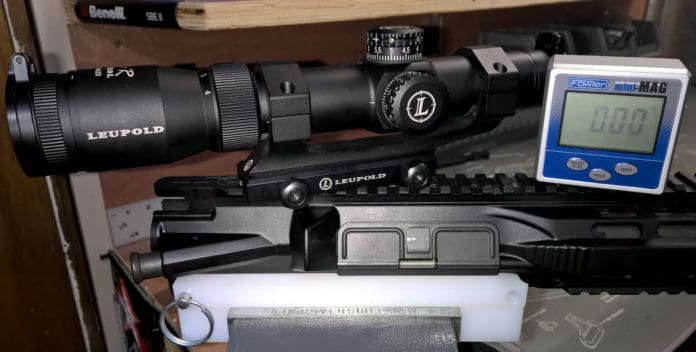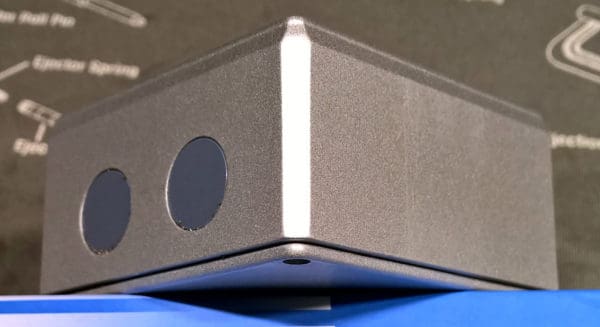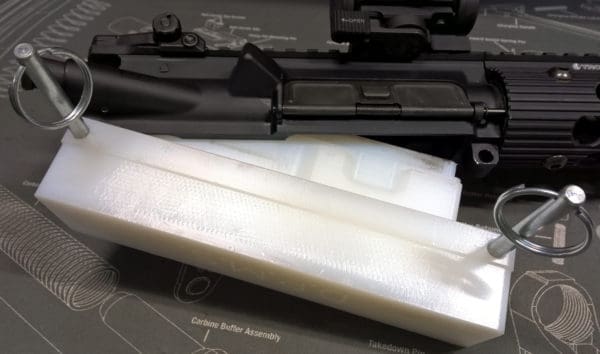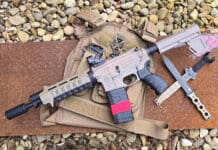C.a.R Firearms is a small shop that specializes in custom work and related services (think build vs. assemble) located south of Seattle. Every time I’m there I make a mess, drooling over fantastic, precision-built guns — either their creations or customer-owned.
But mostly, I enjoy visiting C.a.R Firearms because the proprietor, Fred Hastings, and his staff are solid guys. They provide one on one attention, sweat the small stuff, and work hard to deliver the very best for any customer, large or small.
Fred is a combat veteran with a professional background in CNC machining R&D. He started C.a.R. Firearms as a way to treat his PTSD. It’s wonderful to see him help himself by helping others. When Fred found out I’d never used a digital protractor for firearms, he was more than willing to share how he uses the measuring instrument to satisfy a shooter’s thirst for correcting alignment and accuracy.
A digital protractor measures angles, with most measuring a range of 0° to 180° or 360°. The Fowler Mini-Mag measures a total of 360° by way of its four sides, each providing 90° of inclination and declination data, either relative (by zeroing off of a surface) or absolute.
On Fred’s recommendation, I picked up the Fowler Mini-Mag (above) for $63 on Amazon.
At a basic level (no pun intended) a digital protractor serves the same purpose as any bubble-level set. It simply provides a much more precise, digital reading.
I’ve used the above Wheeler bubble levels for the past few years with decent, sometimes “perfect” results (based on double-checking with the digital protractor, of course). It must be said: in very rare instances, a clamp-on bubble level may be your only option for ensuring proper scope alignment.
The Mini-Mag has an alloy housing, 3.5 lb pull magnets on three of four sides, a large readout screen, and your standard functions (zero, hold, calibrate, etc.). Onscreen icons indicate tilt direction (up or down), low battery, and the type of reading displayed (absolute, relative, or hold).
I wish the battery panel had an O-ring seal. Anyway, in addition to a digital protractor, Fred’s scope mounting process calls for the following tools:
Aside from a vise (not pictured), the above tools are Fred’s current preferences; there are some suitable substitutions, of course (noted below). From left to right in the photo:
- Torque Wrench: Vortex Optics Torque Wrench (tube case, wrench, bits in bag)
-
Digital Protractor: Fowler Mini-Mag
-
T-Wrench: Schultz & Larsen Red Handle T-Wrench (optional if you have a toque wrench)
-
Upper Receiver Block: The Device Manufacturing AR-15/M16 Upper Receiver Fixture (2 pieces)
Regarding suitable substitutions, a Wheeler F.A.T. Wrench (above, left) or even Fix It Sticks Kit (above, right) (if you have the correct torque bit) will work just as well.
Certainly not every home shop warrants a $300 Device Manufacturing Upper Receiver Fixture. There are plenty of good, less expensive alternatives out there. I can attest that The Device’s block has far superior lock-up inside the upper receiver. It also provides a very nice rail section for mounting scopes to rings, absent a firearm.
For this process a Geissele Reaction Rod was not an acceptable alternative from Fred’s perspective. It allows for a variance of play, considering that the differences in chamber lugs and wear of those lugs can lead to a variety of tolerances.
The Scope Mounting Process
The steps outlined below assume you have already double-checked the compatibility of your optic/mount/weapon combination, lapped your rings (should you choose to do so), and mocked-up the optic on your weapon to determine proper placement with eye relief as a central consideration.
It also assumes that your optic has an appropriate vertical or horizontal flat spot from which to take a reading with the protractor. This demonstration utilizes an AR-15 style rifle, the Armalite M15A4 SPR Mod1, but is applicable to many weapon systems.
Step 1: Firmly mount your firearm to a rock-solid vice by way of an upper receiver block or other appropriate device. Ensure neither the firearm, mount, nor vice can inadvertently shift out of place during the scope mounting process.
Step 2: Turn on your digital protractor and place it on a flat spot on the upper receiver (not the handguard, unless you have a monolithic upper…then maybe). This process uses relative leveling so zero-out the protractor. Check several spots along the upper receiver to ensure the integrity of the rail.
If you are using the Fowler Mini-Mag remember to keep it moving from this point on as it will reset after five minutes of no activity.
Step 3: Mount the bottom half of your rings to the rail and lock them down (consider blue Loctite 242). If you have horizontally or vertically-split rings, for kicks, take a look and see if they are level with each other. The Leupold rings above were off slightly – certainly not enough to cause worry or warrant corrective action.
Notice that Fred likes to use the protractor upside-down. He does so because the top surface of the protractor is the side with no magnets, and the buttons are easier to manipulate on top.
Step 4: With the t-wrench, snug your optic into the mount so that you can barely rotate it. When placing your optic in the mount, be sure to take into account your pre-calculated eye relief. Again, consider blue Loctite 242.
Step 5: Set your zeroed digital protractor onto the flat spot of your optic (most likely a turret) and slowly rotate your optic until you get triple-zeros. Your optic is now level with your upper receiver. If taking your measurement off of a side turret, simply use the side of the digital protractor – do not turn the protractor 90°.
Step 6: Keeping your protractor in place to monitor change, ensure your torque wrench is set to the appropriate specification and begin slowly tightening the rings evenly and in a crossing pattern.
First, tighten until you feel resistance at each screw. Then use several passes of limited rotation to make certain the gaps between the halves of the rings are equal, until you click-off on each screw (indicating you’ve met the torque specification).
If your protractor indicates a change in the optic’s relative position to the upper’s rail, you’ll need to adjust your approach for how you tighten each individual screw, adjust the scope within the rings to compensate for the movement, or consider lapping your rings and trying again (presuming the rings are uneven and pushing the optic out of alignment).
Once you’re locked-in to specifications, remove your protractor from your optic, and then set it back down in the same spot to double-check the reading.
You can triple-check using an available pre-qualified section of rail. Look into your optic and line up the reticle with a right angle (like a door frame) and conduct a visual assessment of your reticle for proper alignment of cross-hairs or other markings, relative to the upper receiver.
The straight-forward, simple process complete, once everything checks out satisfactorily you should be set to re-assemble the firearm (if necessary) and head out to the range to dial-in the optic.
Other Handy Uses
Fred, being who he is, instinctively checked the gas block on each of the three firearms I brought in that day. Above, the Armalite’s gas block was off slightly so he took the liberty of bringing it back in-line.
A digital protractor also works really well for timing muzzle devices. Many devices have a flat spot at the 0°, 90°, 180°, and/or 270° positions from which you can take your reading. When muzzle devices are absent a flat side, you may need to get a little creative, as demonstrated in the photo above.
If you spend more than a few hours a month working on firearms, a digital protractor is well worth the investment. As soon as you have one in hand you may want to block out the next day or two because you’ll most likely be checking and re-mounting many of your rails, optics, and muzzle devices.
And if you’re like Fred, it will feel like the right thing to do. If you’re not, that’s fine – your guns may still run. But then why did you read this article?




















I mounted a scope recently with a couple conventional rings and a Pic rail. I noticed that there is a nice flat surface on the bottom of the scope directly opposite the elevation knob. And that scope surface should be parallel to the top of the Pic rail.
So using the inside measurement prongs of a digital calipers, I measured the distance between the left side of the Pic rail and the scope, and then again on the right side of the Pic rail. Adjust until both sides are equal. This may or may not work with the fancy one piece ring and clamp mount shown in the article.
Wow.. so much uselessness, so little time. The scope/reticle does NOT need to be level to the rifle in any manner. The reticle needs to be level to the earth at all times.
The ONLY thing that is needed is a scope level that is leveled to the reticle. If not your elevation and windage are not in line. I know lots of shooters purposely cant their stock because its more comfortable. That works perfectly as long as the reticle is level to the earth.
Your eye can NOT see if the reticle is level with enough precision. A level on the gunner scope must be used.
Just one more example of bad advice from “someone on the internet” instead of learning from a professional
So of your reticle isn’t perpendicular or parallel to the offset between the scope and bore nothing will be wonky? Personal experience would suggest otherwise, but it wouldn’t be the first time I’ve over thought something.
The bore is round, the relation of it to the scope is meaningless.
The reticle needs to be level so the vertical movements don’t also shift sideways and the windage doesn’t also shift vertically. As an example, if your reticle is off my 5 degrees, your vertical turret changes will not only change elevation but will also move to the side.
Best option for a level is scope mount so you can cant your stock if you like. In that case you only need to level the reticle to the radical.
If you mount the level on the rifle, you must level your reticle to the rifle. Much easier using a scope mounted level.
It is not possible to judge if the reticle is level with enough precision with just the naked eye, which is my a level is also needed. All depends on the level of accuracy you want. If you want to hit a 11″x14″ target at 100 yards, it wont matter much. If you want to hit a dime at 100 yards, it will matter greatly
My method is to angle the stock to what ever is a comfortable shooting position, then rotate my scope until the reticle is level to a known object that is level, then tighten down the scope.
Then, keeping the gun in the same position, I rotate the scope level until it is level, then tighten it down. The level is now matched to the reticle. I can move the scope to another gun if needed and it won’t have to be leveled again since the level is on the scope.
That works, if your bore axis is parallel to your sight axis, and you input the offsets into your ballistics solver. If they are not parallel, because you have a scope mount or rail with built in elevation, that angle needs to be parallel with the vertical crosshair line. I don’t know anyone who shoots a precision rifle without some elevation in the mount. My .22LR has 15 mrad between the picatinny rail and Spuhr mount.
Hold a scope up to your eye and align the reticle to an object and hold it still. As you angle your head left and right, the reticle is still aligned to the object
Now think of the rifle taking the place of your head. its angle does not matter as long as the reticle is level
Such confidence in ignorance is amazing.
D,
I am with you on this one.
As long as your reticle is plum/level to Earth, you can send bullets in a known/predictable manner downrange — regardless of the range.
And even for the people who think otherwise, what makes you think that the sides of a rifle receiver are EXACTLY plum, parallel, and centered with the vertical center line of your barrel’s bore axis? And what makes you think that the top turret is exactly 90.00 degrees relative to a line which is exactly parallel with the vertical line of your barrel’s bore axis? And what makes you think that your scope’s reticle aligns with (or is exactly 90.00 degrees to) any of those alleged datums/references?
Pro tip: none of your rifle’s nor your scope’s surfaces are guaranteed to be 0.00 degrees accurate relative to any other surface — nor your scope’s reticle.
Caveat:
Everything flies out the window if you want to dial-in corrections with your scope turrets rather than using hold-over with a fancy reticle.
If you wanted to use dial-in corrections, you would first have to ensure that your turrets actually move your scope exactly parallel with the corresponding line on your scope’s reticle. I cannot think of any way to do that other than shot strings while you dial each turret — to ensure that your shot strings move perfectly vertical as you change your elevation turret for example (all while keeping your reticle perfectly vertical throughout the shot string).
Put the 3 Wheeler levels on the same surface and I would bet they will all show a different readings
In a pinch you can use a standard bench vice on the part of an AR upper that the takedown pins go through. I have plastic soft jaws but some thin wood like popsicle sticks or mixing sticks would protect the upper receiver.
From a Leupold 2013 riflescope owner’s manual, Rev. G.
COMPLETING THE INSTALLATION
1. Without disturbing the optimal eye relief position, rotate the
scope until the elevation adjustment dial is at the top of the
scope.
2. From a firing position, check to be sure that the vertical hair
of the reticle aligns with the vertical axis of the firearm.
Misalignment will not affect accuracy at moderate distances but
it can diminish long range accuracy.
3. When you are satisfied, tighten the ring screws evenly
and securely.
I guess the guys at Leupold should have consulted a professional before writing their manual.
Written for the lowest common denominator shooter which apparently is you
Messed up the formatting. I guess I should have consulted an HTML professional. The text is verbatim though.
Comments has made me think outside my traditional box. I use magnetic bubble levels to level the unscoped rifle which is sitting in a lead sled. Once that is done I’ll mount the rings where I want and lap them. Visually rotate scope and align vertical line with neighbors house corner (about 200 yards away through glass door) Put bubbles back on to check and recheck, torque to manufacturers in/lb.
The CM I’m putting together will have a 20moa rail so leveling the scope to exactly parallel to the ground regardless of cant of rifle seems the way to do it. I do believe I will buy this device or similar going forward. Would also like to check out old rifles I own too.
I’m going to have to try an X pattern when I wrap the duct tape. The one direction wrap always pulls my scope to one side or the other.
Assumptionally, Kalashnikov didn’t mean for his rifle to be scoped as the iron sights are all a good russky needs.
Misalignment of the vertical reticle with the bore axis may not have a practical impact on point of impact but it does have some. A scope mounted 1.5 inches above the bore with the vertical reticle canted 5 degrees creates an horizontal offset of .1312 inches between line of sight and bore axis. Using the windage dial to zero at 100 yards then introduces a error of .1312 each additional 100 yards resulting in a built in windage error of 1.188 inches at 1,000 yards. Increasing the scope height to 2 inches and the cant to 10 degrees results in an initial offset of .3526 inches. With 100 yard zero error ant 1,000 yards is 3.17″
How would this be corrected so that the vertical crosshair is exactly in-line with the bore? (not eyeballing it)
There are numerous methods and tools specifically for the purpose. Having said that, many scopes are mounted by armorers and even gunsmiths using the eyeball method. Placing the rifle on a rest or in a vise, put your cheek behind the butt of the stock and look through the scope. You should be able to see the vertical crosshair and rotate the scope until the crosshair is inline with the center line of the butt plate.
Probably the most common method utilizing tools or aides is the leveling method. I use barrel blocks in a bench vise to securely hold the rifle and a 2.5″ machinist level to level across the receiver, rings, or scope mount. Then install the scope, leveling across turret knobs. Check with eyeball method. The big advantage of the digital protractor described in the article is it takes a “relative reading.” Meaning you do not have to get the receiver exactly level making the process much quicker and easier.
Recently I have started using the “parallels method.” By far the fastest and easiest for me. You can use a set of feeler gauges or a set of ground angle blocks. Link below has video demonstrating. Only issue is you must have flat surface to gauge off of.
https://arisakadefense.com/optic-leveler-combo/
I have no idea how I ever mounted the scopes to my many rifles through the years without the advice of some of the experts on this site. The hubris of many of the comments is unbelievable….
What is your method?
How do you ensure that the vertical is exactly vertical? As I stated earlier, I line up with corner of neighbors house around 200 yards. Basically I’m eyeballing it really. I’m open minded to any and all different methods. I would love to have a more precise method.